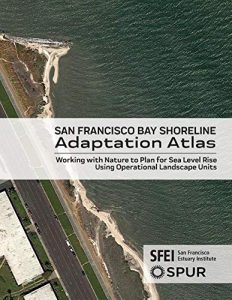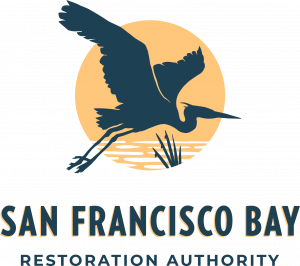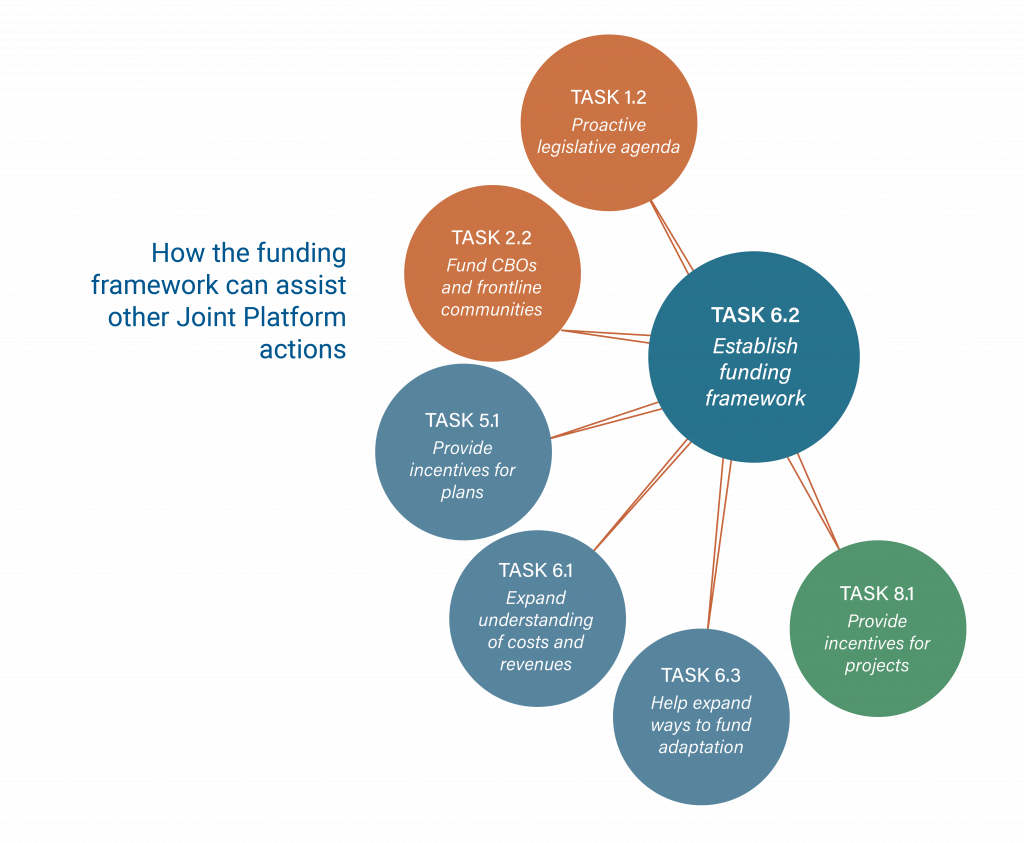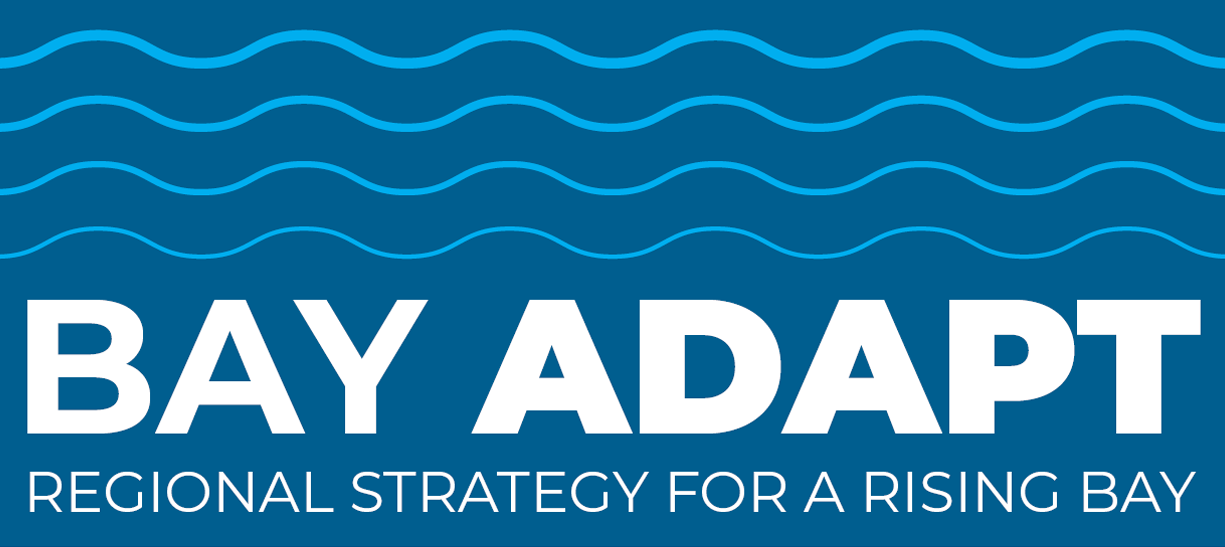
PLANS
Now is the time to plan for carrying out the region’s adaptation vision and seeking the billions of dollars needed to pay for it.
As shoreline communities incorporate adaptation into local plans, we must ensure that those plans contribute to a “One Bay” solution, whose goals and objectives are shared across cities, counties and the region. Decisions in one community, municipality or new development can displace costs and impacts to others. How can we help locals make successful, coordinated plans? And how will we pay for new initiatives?
Explore Actions and Tasks
- ACTION 5: Align local and regional plans into a unified adaptation approach.
- Task 5.1: Provide incentives for robust, coordinated local adaptation plans.
- Task 5.2: Align state-mandated planning processes around adaptation.
- ACTION 6: Figure out how to fund adaptation.
- Task 6.1: Expand understanding of the financial costs and revenues associated with regional adaptation.
- Task 6.2: Establish a framework for funding plans and projects.
- Task 6.3: Help cities and counties expand ways to fund adaptation planning and projects.

ACTION 5: Align local and regional plans into a unified adaptation approach.
Goals:
- Local plans that are coordinated across the region, and incentivized by expanded adaptation funding.
- Improved and coordinated state planning requirements for adaptation plans and projects.
TASK 5.1: Provide incentives for robust, coordinated local adaptation plans.
Utilize collectively-developed plan guidelines and minimum requirements (Task 1.1), tied to financial incentives (Task 6.2), to develop strong local and community-driven adaptation plans that also contribute to regional goals and align with current state guidelines for adaptation plans. Incentives should include funding to develop the plans. Plans should also include planned projects that contribute to regional goals (Task 8.1).
Guidelines should be developed with the input of many stakeholders but may provide:
- Guidance on how to prioritize and include vulnerable communities in sea level rise planning, including best practices for community engagement and community-led adaptation planning processes.
- Common minimum short and long-term sea level rise climate projections for planning.
Standard flood data sets. - Regionally-appropriate strategies for protecting natural areas, frontline communities, public access, regional transportation links, and other critical regional assets.
- Guidance on how and where to prioritize nature-based solutions along the shoreline where feasible and appropriate.
- Land use guidance, such as how to plan for habitat migration with sea level rise.
- Guidance on how to plan for long-term implications of sea level rise beyond current planning horizons.
- Guidance on how to connect sea level rise planning to other critical topics, including public and environmental health, emergency response, and housing considerations.
Assistance on applying the guidelines should be available through regional technical assistance programs (Task 4.2).
See Task 5.1 in the Draft Implementation Brief for details and ideas for advancing the Joint Platform actions.
TASK 5.2: Align state-mandated planning processes around adaptation.
Assess the state’s myriad planning requirements beyond adaptation (such as those for housing, emergency response, local hazard mitigation, social equity, and climate action) through the lens of adaptation planning for conflicts, redundancies, and synergies. Jointly advocate for updated legislation to coordinate these requirements. Also create opportunities and incentives at the state level for cross-jurisdictional planning to improve the siloed scope of local plans that are often limited to jurisdictional boundaries.
See Task 5.2 in the Draft Implementation Brief for details and ideas for advancing the Joint Platform actions.
 The San Francisco Bay Shoreline Adaptation Atlas has extensively evaluated the Bay shoreline to identify the most appropriate adaptation strategies for the unique physical characteristics shared by different “Operational Landscape Units” around the Bay. It identifies where nature-based approaches can help create a resilient shoreline with multiple benefits and where these solutions can work together across the interconnected Bay to avoid unintended impacts in neighboring locales. The Adaptation Atlas can provide a guide toward appropriate plans and projects in different locations around the Bay to ensure that the most appropriate strategies are considered in any given location. See it Here.
The San Francisco Bay Shoreline Adaptation Atlas has extensively evaluated the Bay shoreline to identify the most appropriate adaptation strategies for the unique physical characteristics shared by different “Operational Landscape Units” around the Bay. It identifies where nature-based approaches can help create a resilient shoreline with multiple benefits and where these solutions can work together across the interconnected Bay to avoid unintended impacts in neighboring locales. The Adaptation Atlas can provide a guide toward appropriate plans and projects in different locations around the Bay to ensure that the most appropriate strategies are considered in any given location. See it Here.
Action 5 Benefits

EQUITY
Rewards planning processes that value inclusive engagement and equitable outcomes.

ENVIRONMENT
Rewards planning processes that value long-term protection of Bay habitats and prioritization natural and nature-based adaptation outcomes.

ECONOMY
Rewards planning processes that value the protection of jobs, businesses, and infrastructure.

ACTION 6: Figure out how to fund adaptation.
Goals:
- Clear assessment of the region’s adaptation funding needs.
- Identification of local and regional funding sources and financing tools.
- Mechanism for prioritizing and distributing funds for adaptation over the next several decades.
TASK 6.1: Expand understanding of the financial costs and revenues associated with regional adaptation.
Reduce unknowns and uncertainties related to the costs of adaptation. Start by expanding on the existing MTC/ABAG Sea Level Rise Needs and Revenue Assessment, which supports Plan Bay Area 2050 and also advocates for more state and federal funding. Build on and improve the assessment’s calculations of what it may cost the region to adapt to sea level rise as well as the cost of inaction. As part of this calculation, consider both actual costs of current projects and the anticipated costs of untested or new construction or restoration techniques, as well as the costs for pre-construction phases of projects such as engagement, planning, and land acquisition or post-construction costs such as monitoring and maintenance. Consider when future funds may be needed as sea levels rise and impacts accelerate. Also develop a more in-depth understanding of possible revenue from related special assessments, taxes, and fees to refine estimates of the potential funding gap.
See Task 6.1 in the Draft Implementation Brief for details and ideas for advancing the Joint Platform actions.
 The San Francisco Bay Restoration Authority is a regional agency created to fund shoreline projects that will protect, restore, and enhance San Francisco Bay through the allocation of funds raised by the Measure AA parcel tax. This parcel tax generates $25 million in grants annually for wetland restoration projects throughout the region. The Restoration Authority is overseen and staffed by representatives from several Bay Area government agencies with various types of expertise and authority. The Restoration Authority could either be expanded to fund a wider variety of adaptation projects or could serve as a model for a new adaptation-focused finance authority for the Bay. Learn More Here.
The San Francisco Bay Restoration Authority is a regional agency created to fund shoreline projects that will protect, restore, and enhance San Francisco Bay through the allocation of funds raised by the Measure AA parcel tax. This parcel tax generates $25 million in grants annually for wetland restoration projects throughout the region. The Restoration Authority is overseen and staffed by representatives from several Bay Area government agencies with various types of expertise and authority. The Restoration Authority could either be expanded to fund a wider variety of adaptation projects or could serve as a model for a new adaptation-focused finance authority for the Bay. Learn More Here.
TASK 6.2: Establish a framework for funding plans and projects.
Develop and implement a framework or process to aggregate, generate, and distribute adaptation funding for communities, plans and projects. Use guidelines developed in Task 1.1 to direct funding to incentivize successful local planning (Task 5.1), and to evaluate and assign funding to proposed adaptation projects included in such plans (Task 8.1). Consider modeling the process on the MTC/ABAG Transportation Project Performance framework, in which partners nominate local projects for evaluation based on specific criteria and then prioritize them for funding. Actively advocate for adaptation funding for the region (Task 1.2) and consider spearheading new regional taxes, fees, or other financing mechanisms to fund plans and projects.

Task 6.2 is a foundational task that connects to many other tasks in the Joint Platform.
See Task 6.2 in the Draft Implementation Brief for details and ideas for advancing the Joint Platform actions.
TASK 6.3: Help cities and counties expand ways to fund adaptation planning and projects.
Provide local governments with expertise and assistance to generate additional funds by identifying, evaluating, and applying local financing tools and to apply for other sources of funds for local adaptation needs (above and beyond any regional funds identified in Task 6.2). Work with cities and counties to identify their needs and match the myriad federal, state, regional, and local funding sources to local needs for planning, community engagement, project implementation and costly project resources (i.e. sediment). Help local governments understand grant requirements and shape projects to fit them. Assist with project cost-benefit analysis, grant writing, and fulfilling reporting requirements. This assistance should be provided through the regional technical assistance storefront outlined in Task 4.2.
See Task 6.3 in the Draft Implementation Brief for details and ideas for advancing the Joint Platform actions.
There are several existing resources that can help serve as the foundation for the services outlined in Task 6.3:
- Finance Guide for Resilient by Design Bay Area Challenge Design Teams, NHA Advisors, 2018
- Paying for Climate Adaptation in California, AECOM, 2018
- Climate Adaptation Finance and Investment in California, Routledge Focus, 2018
- Adaptation Finance Challenges: Characteristic Patterns Facing California Local Governments and Ways to Overcome Them, California Natural Resources Agency, 2018
- The California Grants Portal is an access portal to all grants and loans offered on a competitive or first-come basis by California state agencies. Learn more here.
- The Funding Wizard, hosted and maintained by the California Air Resources Board, is a searchable database of grants geared toward sustainability projects, including climate change mitigation and adaptation. Learn more here.
Action 6 Benefits

EQUITY
Outlines a process to pay for adaptation that does not rely on a community’s wealth, advocacy skills, or grant-writing success to fund plans and projects.

ENVIRONMENT
Identifies ways to prioritize long-term protection of Bay habitats and natural and nature-based adaptation outcomes in funding decisions.

ECONOMY
Increases funding for shoreline projects and protection of key assets critical to the region’s economic health.





